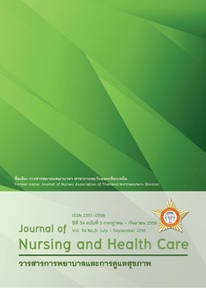การพัฒนาการดูแลผู้ป่วยวัณโรคปอดอย่างมีส่วนร่วมในชุมชนอำเภอเมือง จังหวัดพิษณุโลก The Development of Community Participation amongPulmonary Tuberculosis Patients In Muang District, Phitsanulok Province
คำสำคัญ:
การดูแลผู้ป่วยวัณโรคปอดในชุมชน การมีส่วนร่วม วัณโรคปอด TB care in the community, participation, TBบทคัดย่อ
บทคัดย่อ
การวิจัยเชิงปฏิบัติการนี้ มีวัตถุประสงค์เพื่อวิเคราะห์สถานการณ์และพัฒนาการดูแลผู้ป่วยวัณโรคปอดในชุมชนของ
รพ.สต.ในเขตอำเภอเมือง จังหวัดพิษณุโลก มี 2 วงรอบๆ ละ 4 ขั้นตอน คือ 1) ศึกษาสถานการณ์และวิเคราะห์ปัญหาการดูแลผู้ป่วยวัณโรคปอดในชุมชนโดยการเก็บรวบรวมข้อมูลจากทะเบียนและรายงานที่เกี่ยวข้องพร้อมทั้งการสัมภาษณ์ และการสังเกต 2) วางแผน เลือกแนวทางการแก้ไขปัญหาและจัดทำแผนการดำเนินงานโดยจัดการประชุมเสวนาร่วมกันผู้วิจัยและผู้ร่วมวิจัย 3) ดำเนินการปฏิบัติตามแผน สะท้อนผลการปฏิบัติ และปรับปรุง และ 4) ประเมินผล เครื่องมือที่ใช้ในการวิจัยได้แก่ แบบสัมภาษณ์กึ่งโครงสร้าง สัมภาษณ์ผู้ร่วมวิจัย 74 คน วิเคราะห์ข้อมูลเชิงปริมาณด้วยสถิติเชิงพรรณนา ข้อมูลเชิงคุณภาพใช้การวิเคราะห์เชิงเนื้อหาผลการวิจัย จากการวิเคราะห์สถานการณ์และปัญหาการดูแลผู้ป่วยวัณโรคปอดในชุมชน พบว่า 1) ขาดการมีส่วนร่วมของชุมชนในการดูแลผู้ป่วยวัณโรคปอดในชุมชน เนื่องจากผู้ป่วยวัณโรคปอด มีความรู้ความเข้าใจเกี่ยวกับวัณโรคน้อยโดยมีการรับประทานยา พี่เลี้ยงผู้ป่วยวัณโรคปอดมีความรู้ไม่เพียงพอเกี่ยวกับเรื่องวัณโรค ไม่เข้าใจบทบาทที่ อสม.มีความรู้ไม่เพียงพอ ขาดความมั่นใจในการดูแลผู้ป่วยวัณโรคปอด และการค้นหาผู้ป่วยรายใหม่ในชุมชน ผู้นำชุมชนไม่มีข้อมูลอีกทั้งเจ้าหน้าที่ไม่มีแผนงานในการดูแลผู้ป่วยวัณโรคปอดในชุมชน 2) เจ้าหน้าที่ที่เกี่ยวข้องในการดูแลผู้ป่วยวัณโรคปอดไม่มีแนวทาง/ กิจกรรมการดูแลผู้ป่วยวัณโรคปอดอย่างต่อเนื่องในชุมชน ผู้ป่วยไม่ได้รับการติดตามเยี่ยมบ้านอย่างต่อเนื่องจึงได้ร่วมกันพัฒนาแผนงานการดำเนินงานแก้ไขปัญหา ดังนี้ 1) แผนการพัฒนาอบรมความรู้เรื่องวัณโรค การดูแลผู้ป่วยวัณโรคปอด และทักษะเกี่ยวกับการคน้ หาผูป้ ว่ ยวัณโรคปอดในกลุม่ เสี่ยงใหกั้บอาสาสมัครสาธารณสุขประจำหมูบ่ า้ นและผูน้ ำชุมชน 2) แผนการให้ความรู้เรื่องวัณโรคและการปฏิบัติตัวที่ถูกต้องกับผู้ป่วยวัณโรคปอด และพี่เลี้ยงผู้ป่วยวัณโรคปอดโดยการติดตามเยี่ยมบ้าน 3) แผนการดูแลผู้ป่วยวัณโรคปอดอย่างต่อเนื่องในชุมชนผลจากการนำแผนการดำเนินงานการพัฒนาไปใช้ พบว่า ผู้ป่วยวัณโรคมีความรู้ความเข้าใจในการดูแลตนเองมากขึ้นและได้รับการดูแลที่ต่อเนื่อง พี่เลี้ยงผู้ป่วยวัณโรคปอดมีความรู้ในการดูแลผู้ป่วยวัณโรคเพิ่มมากขึ้น อาสาสมัครสาธารณสุขประจำหมู่บ้านมีความรู้ ความมั่นใจในการดูแลผู้ป่วยวัณโรคปอดในชุมชน เจ้าหน้าที่ที่มีส่วนเกี่ยวข้องมีแผนงานในการดูแลผู้ป่วยวัณโรคปอดในชุมชน อีกทั้งทุกภาคส่วนได้มีส่วนร่วมในการดูแลผู้ป่วยวัณโรคปอดในชุมชนอย่างต่อเนื่อง และมีประสิทธิภาพมากขึ้น ทำให้เกิดผลสำเร็จในด้านการดูแลผู้ป่วยวัณโรคปอด และเกิดประโยชน์สูงสุดกับผู้ป่วยวัณโรคปอดอย่างแท้จริง
Abstract
This action research was conducted with the aims to analyze the pulmonary tuberculosis (TB) care and develop the care service for pulmonary TB patients in Muang District, Phitsanulok Province. The study was implemented in two cycles that encompassed four phases. Phase 1 was situational analysis of problems associated with TB care in the community. Data were collected from medical records, health reports, interviews,
and observations. Phase 2 was carried out among the researcher and research participants to identify options and develop the plan for TB care. Phase 3 was undertaken to implement the plan, reflect results and revise the intervention. Lastly, phase 4 was conducted to evaluate the outcomes. A semi-structured questionnaire was used to collect data from 74 participants. Quantitative data were analyzed to obtain frequencies and percentages. A
content analysis was used to examine qualitative information. Results from a situational analysis indicated that the community minimally participated in TB care. TB patients
lacked of sufficient knowledge about the disease with the average score of only 62.4%. Patients reported incorrect self-care practice. Only 59.4% of the patients had caregivers who supervised their medication taking. Caregivers lacked TB-related knowledge and did not understand their roles in TB care. The village health volunteers also lacked sufficient knowledge and felt unconfident in both caring for TB patients and identifying new cases.
Community leaders were unaware of TB situation in the community and responsible personnel. In addition, the health personnel did not have proper plan for TB-continuing care in the community because they were often assigned new responsibilities. They never had meetings to develop the care plan and delegate responsibilities. Subsequently, TB patients did not received continuing care through home visits. As a result, the participatory
community TB care was developed to address these issues. Three service plans were constructed including 1) aTB knowledge workshop about caring for patients with TB and new cases identification skills for the village health volunteers and community leaders, 2) TB health education about the disease and proper self-care practice for TB
patients and their caregivers, and 3) a participatory community TB continuing care plan.
After the project implementation TB patients reported increased knowledge and understanding related to self-care practice as well as continuing care in the community. Caregivers also had improved TB care-related knowledge. The health volunteers had increased knowledge and confidence in caring for TB patients in the community. Administrative and health personnel developed a community TB care plan with the participation from all stakeholders that resulted in effective continuing TB care. This resulted in increased success in TB care and maximized the benefits for TB patients in the community.



